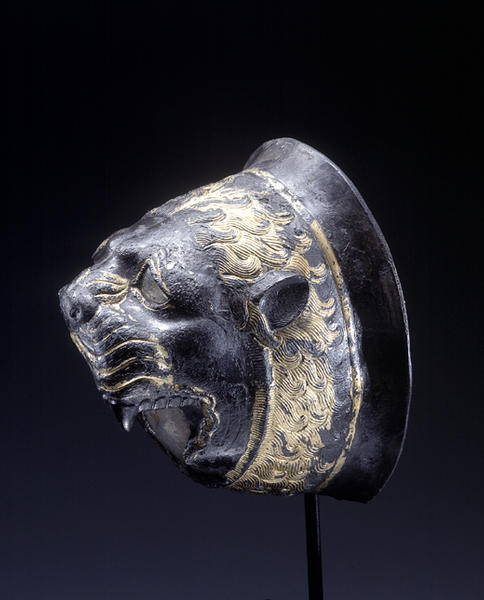Situla with a Lion's Head
- Achaemenid period
- 5th-4th centuries BC
- Silver with gilding
- H-12.5 D-12 W-15.3
Catalogue Entry
ca. 5th‐3rd century B.C.
Gilded silver
H. 12.5 cm, W. 15.3 cm, Depth 12.0 cm
This vessel has a lion's head-shaped end which is fitted to a round-bottomed vessel, and is a type of cup that had been created in West Asia since antiquity. The standing ridge, collar-like mane which runs from beneath the ears around the jaw line also traces its origins far back into West Asian history. The eyes are fitted from the inside with crystal insets. The wide open mouth was generally shown in West Asia by a simple curved line, but here we can see the wavy lips shown in a realistic form not found in West Asia. This form is found in architectural and jewelry design from the Greek cultural sphere which spread from the Mediterranean to the Black Sea region. Persian art depictions of lion manes were normally scale-like and formalized and the ears were shown held flat against the head. Instead, here we see the elegantly raised mane hairs, and the raised, opened ears. These elements reveal a sense for realism that would have originated in the Mediterranean region. A lion head decoration that would have been attached to the bracelets, excavated from the Pantikapaion on the Crimean Peninsula and today in the Hermitage collection, may show the model for the present lion head's expression.
Similar lion expressions can be found on an ivory sword sheath excavated at Takht-I Sangin. This sword sheath was thought to have been brought to the region from Persia along with Alexander the Great's eastern conquest, but in fact this sheath can be thought to be one of ivory works made in Central Asia, in the style with strong influence of Greeks. These images of lions can be called a Central Asian style that nimbly blends the aesthetics of East and West.
Vessels
The "vessels" division is represented by a relatively large number of objects.There are 22 items of gold (cat. Nos. 123-144) and 26 of silver (cat. Nos. 97-122). Among the silver vessels, there are 6 goblets (cat. Nos. 103-106, 108, 109) tall libation vessels Achaemenid in form, but decorated in a style which is typically Hellenistic. Similar cups are held by the magi represented on the relief sculptures and votive plaques. Three rhyta made for a similar purpose are unfortunately in a fragmentary condition (cat. Nos. 118, 119, 122). In addition there are 8 shallow bowls (cat. Nos. 97-99, 101, 102, 111-113) for ritual libations. The gold vessels were used for the same purpose; there are 18 libation bowls, of simple form, most of which have a rounded base and everted rim (cat. Nos. 123-140). One tall vessel of a pyxis type with a lid (cat. No. 142) appears to be the earliest of the vessels in the collection. Of special interest is an incense burner in the form of a censer with four rings for suspension (cat. No. 141).
Although the number of vessels in this collection is considerably larger than those of the Oxus Treasure in the British Museum, they probably served the same function. The vessels of both collections are closely paralleled by the vessels held by worshippers depicted on the Persepolis reliefs. This observation makes it possible to date them. It is worth adding here that the manufacture of goblets of similar shape and of rhyta in the Persepolitan style is depicted on a relief in a pronaos on the northern wall of the tomb of Petosiris at Hermopolis Magna in Egypt. According to Muscarella, the reliefs attest the manufacture of embossed articles in Egypt right up until 300 BC.
Rhyton with a Stag
Censer
Shallow Bowl with a Rosette Pattern
Shallow Bowl with a Rosette Pattern
Phiale with a Rosette Pattern
Bowl with a Rosette Pattern
Phiale
Fragment of a Shallow Bowl
Bowl with a Rosette Pattern
Bowl with a Rosette Pattern
Bowl with a Rosette Pattern
Bowl with a Rosette Pattern
Bowl with a Lotus and PalmettePattern
Bowl with a Rosette Pattern
Bowl with a Human Heads Decoration
Bowl with a Rosette Pattern
Shallow Bowl with a Leaf
Plate with Ketos
Bowl
Kotyle with Mythical Figures
Rhyton with a horse protome
Horse (Fragment of a rhyton)
Winged Human-headed Bull(Fragment of a rhyton)
Decoration of a Ladle
Disk-like Round Mirror
Lion Griffin (Fragment of a Rhyton)
Shallow Bowl with a Rosette Pattern
Sallow Bowl
Sallow Bowl
Bowl
Sallow Bowl
Bowl
Bowl
Bowl
Bowl
Bowl
Bowl
Bowl
Bowl
Bowl
Bowl
Bowl
Bowl
Bowl
Bowl with Lid
